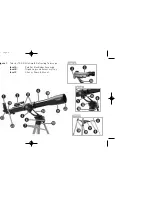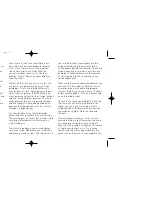
stars and planets. Read about
astronomers of old. Many of them had
telescope no bigger than the one you
are using right now. Galileo, who is one
of the first astronomers to use a
telescope, discovered four of the moons
of Jupiter with a telescope about the
same size as yours (and his didn’t even
focus very well!).
OBSERVING
Observe during the daytime
: Try out your
telescope during the daytime at first. It is
easier to learn how it operates and how to
observe when it is light.
Pick out an easy object to observe
:
A distant mountain, a large tree, a
lighthouse or skyscraper make excellent
targets. Point the optical tube so it lines
up with your object.
Unlock the lock knobs
: To move the
telescope, you will need to unlock the
horizontal lock knob (6) and vertical
locking lever(5) (just rotate to unlock or
lock; when locking, only tighten to a “firm
feel,” do not overtighten).
Use the red dot viewfinder
: If you have not
done so, align the viewfinder (2) with the
telescope’s eyepiece (1) as described earlier.
Look through the viewfinder until you can
see the object. It will be easier to locate an
object using the viewfinder rather than
locating with the eyepiece. Line up the object
with the viewfinders red dot.
Look through the eyepiece
: Once you have
the object lined up in the viewfinder, look
through the optical tube’s eyepiece. If you
have aligned your viewfinder, you will
you see the object in your eyepiece.
Focus
: Look through the eyepiece
and practice focusing on the object
you have chosen.
Try out the slow motion adjustment
controls
: Practice using the slow motion
controls (12 and 16) to move the telescope.
These can come in very handy, especially
when you wish to move the telescope in very
small (fine control) steps.
Observe the Moon
: When you feel
comfortable with the viewfinder, the
eyepieces, the locks and the adjustment
controls, you will be ready to try out the
telescope at night. The Moon is the best
THE MEADE 4M COMMUNITY
You haven’t just bought a telescope, you have embarked
on an astronomy adventure that never ends. Share the
journey with others by accepting your free membership
in the 4M community of astronomers.
Go to www.Meade4M.org to activate your membership
today.
5
SUN WARNING
NEVER USE YOUR TELESCOPE
TO LOOK AT THE SUN!
LOOKING AT OR NEAR THE SUN WILL CAUSE
INSTANT AND IRREVERSIBLE DAMAGE TO
YOUR EYE. EYE DAMAGE IS OFTEN PAINLESS,
SO THERE IS NO WARNING TO THE OBSERVER
THAT DAMAGE HAS OCCURRED UNTIL IT IS
TOO LATE. DO NOT POINT THE TELESCOPE OR
ITS VIEWFINDER AT OR NEAR THE SUN. DO
NOT LOOK THROUGH THE TELESCOPE OR ITS
VIEWFINDER AS IT IS MOVING. CHILDREN
SHOULD ALWAYS HAVE ADULT SUPERVISION
WHILE OBSERVING.
Telestar RB-70.qxd 10/15/08 3:23 PM Page 7
Содержание TELESTAR RB-70
Страница 1: ...N MANUAL fracting Telescope RB 70 M Page 1...
Страница 2: ...M Page 2...
Страница 15: ...or eries n a of an re 13 TY ies l nd M Page 15...
Страница 17: ...ENT GOOD POOR DRAWING OF IMAGE SAVE ORIGINAL BE SURE TO MAKE COPIES RVATION LOG M Page 17...
Страница 18: ...ENT GOOD POOR DRAWING OF IMAGE RVATION LOG M Page 18...
Страница 19: ...M Page 19...
Страница 20: ...www meade com Meade Instruments Corporation 6001 Oak Canyon Irvine California 92618 0 626 3233 M Page 20...


























